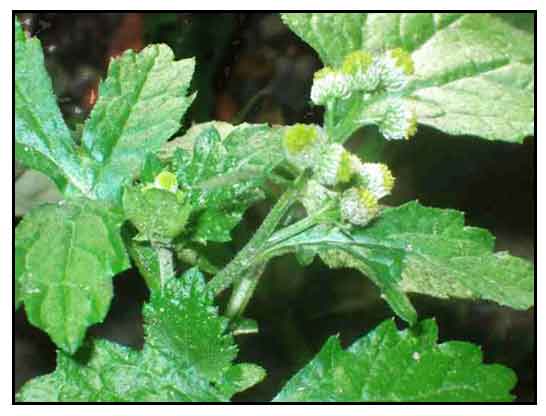 Botany Botany
Dichrocephala latifolia is an annual, erect or spreading, smooth or hairy weed, 30 to 60 centimeters in height. Leaves are entire or pinnatifid, ovate or lanceolate, up to 10.5 centimeters long and 4 centimeters wide; the terminal lobe is large, broadly ovate and coarsely toothed. Flowering heads are yellow or purplish, rounded, and about 3 millimeters in diameter. The ray flowers are very slender, curved, and obscurely toothed. Achenes are very minute and smooth.
 Distribution Distribution
- In open, waste places, old clearings, along trails, etc., chiefly at 900 meters and up to 2,200 meters in Bontoc, Ifugao, Benguet Subprovinces; and Nueva Vizcaya and Quezon Provinces in Luzon; and in Mindoro, Negros, and Mindanao.
- Also occurs in tropical and subtropical Africa, in Asia, and through Malaya.
Constituents
- Study yielded six compounds were obtained and identified as stearic acid, stigmasta-7,22-dien-3-ol, α-amyrin, epifriedelanol, methyl stearate, and tritetracontane. (1)
Properties
- Considered analgesic, anesthetic, anti-inflammatory, antibacterial, diuretic, sudorific, vulnerary.
Parts used
Flower buds, young shoots.
Uses
Folkloric
- Decoction of flower buds used as sudorific and diuretic.
- In Cambodia, young shoots used as poultice for treating blenorrhagia and insect stings.
- In Cameroon, fresh leaves and stems used as anesthetic in atraumatic tooth extraction. It is placed on the fractured, painful, or carious teeth for two to three minutes, causing it to become loose, and then pulled. Plant is reapplied to the extraction site to enhance clotting and arrest bleeding.
- Paste of whole plant used as antidote for Russell viper bite.
Others
- Livestock: In Cameroon used to treat cattle for swelling, infection, necrosis, edema, and pain.
Studies
• Antibacterial: Study evaluated the antibacterial activity of leaf extracts. Results showed chloroform extracts to be the most effective. S. typhi was found most sensitive and P. aeruginosa the most resistant to all extracts used. (3)
• Anticancer: Dichrocephala integrifolia was one of 12 Yemeni herbs that showed inhibitory effect against three human cancer cell lines. (5)
• Anthelmintic: Study evaluated the ovicidal and larvicidal activities of aqueous and ethanolic extracts of leaves of Dichrocephala integrifolia against eggs, first and second larval stages of Heligmosomoides bakeri. Results showed ethanolic extracts contained compounds with ovicidal and larvicidal properties. (6)
Availability
Wild-crafted.
|

![]()



 Botany
Botany Distribution
Distribution